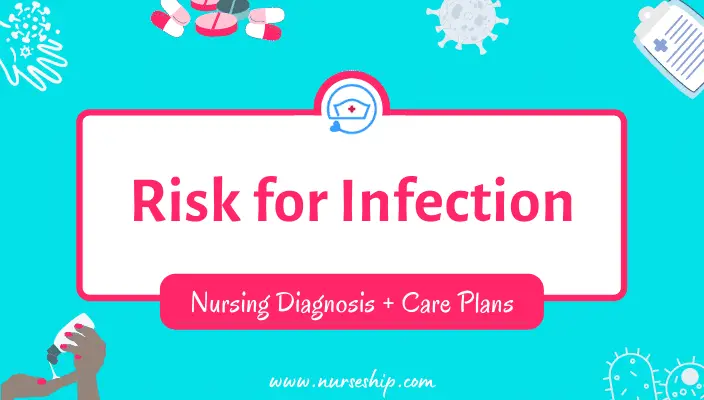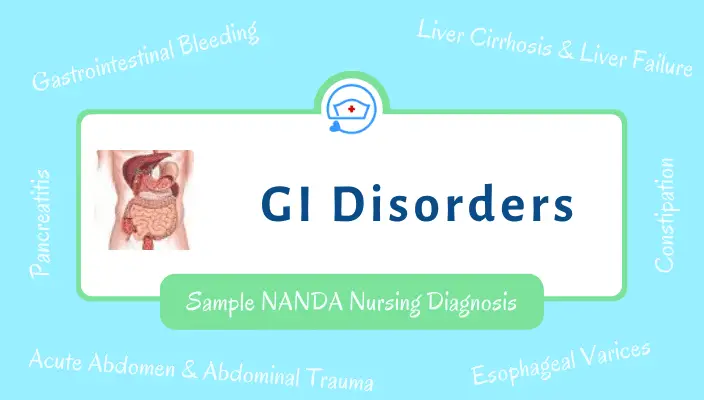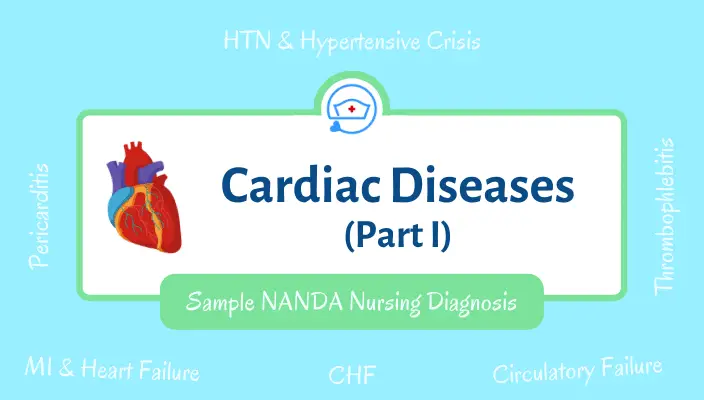Introduction
Risk for infection NANDA nursing diagnosis falls under Domain 11. Which is Safety/protection; Class I.
The other NANDA nursing diagnosis under this category is Risk for surgical site infection.
Risk for infection nursing diagnosis is defined as a condition where the patient is vulnerable to pathogenic microorganism invasion. Which may lead to compromised health status.
The following condition places a patient at Risk for Infection.
- Compromised immune system [ May be due to a disease process (eg; Leukemia, Leukopenia) or long-term medication which suppress immune function (eg; Calcineurin Inhibitors, Steroids)]
- Chronic disease (eg; Diabetes Mellitus, Obesity)
- Invasive procedures
- Long-term indwelling catheters and invasive devices (eg; Urinary catheter, Prosthesis, Surgical implant)
- Premature or prolong rupture of amniotic membrane
Additionally, certain lifestyles, general health status, and environmental pathogens increase the risk for infection.
According to WHO, 7 out of 100 in developed countries and 10 out of 100 acquires at least one nosocomial infection when admitted to a health care facility. Therefore, you should be well aware of the risk factors which predisposes patient to infection.
You should also know the chain of infection and how to disrupt it. And, signs and symptoms of infection to early identification and treatment of infection.
Chain of infection
Following are the six links in the Chain of Infection.
1. The Infectious Agent – pathogenic microorganism that has the potential to cause disease.
2. The Reservoir – where the microorganism grows and multiplies. This can be a person, an animal, object, food, or water.
3. The Portal of Exit – how the microorganism gets out of the reservoir. This can be via coughing, sneezing, feces, vomit, etc. For example, microorganisms are spread by coughing and sneezing in a flu patient.
4. The Mode of Transmission – this is the process through which germs are passed from one person or location to another. This could happen by touch with someone’s hands, an object, the air, or body fluids.
5. The Portal of Entry – this is how the illness spreads to another person. Portal of entry can be mucous membranes, wounds, skin breaks, catheters, inhalation, etc.
6. The Susceptible Host – this refers to the person who is at risk of infection. For example, infants, the elderly, and people with low immune function.
By knowing the chain of infection helps nurses to identify and break the infection chain.
Causes of Infection
Infection is caused by pathogenic microorganisms such as bacteria, viruses, fungi, and parasites. These pathogens may be transmitted via direct contact (eg; sexual contact), indirect contact (eg; airborne transmission), insect bites (eg; lice or ticks), or contaminated food (eg; undercooked meat).
Malnourishment, inadequate sanitary living conditions, certain lifestyle (eg; multiple sexual partners, IV drug paraphernalia, and lack of knowledge about infectious disease transmission increase an individual’s risk for infection.
Signs and Symptoms of Infection
Some of the general signs and symptoms of infection include
- Fever
- Chills and sweats
- Fatigue
- Shortness of breath
- Redness, tenderness, or swelling in any area, including surgical wounds and ports
- Productive cough
- Sore throat
- Sore mouth
- Nasal congestion
- Neck stiffness
- Burning or pain with urination
- Unusual vaginal discharge or irritation
- Urinary frequency
- Diarrhea
- Vomiting
- Pain in the abdomen or rectum
- New onset of pain
- Myalgia
Complications of Infection
- Prolonged healing process
- Amputation
- Sepsis
- Multiple organ failure
- If untreated it may lead to death
Infection Prevention
- Wash your hands before and after visiting the patient or as needed.
- Vaccination
- Follow standard precautions guidelines
- Adheherence to medication regieme
- Appropriate use of PPE
Risk factors related to “Risk for Infection” nursing diagnosis
Common risk factors include:
- Inadequate primary defenses —skin breaks (e.g., IV catheters, surgical incision), traumatized tissue (e.g., blunt trauma); decrease in ciliary action, premature or prolonged rupture of amniotic membranes.
- Inadequate secondary defenses — decreased hemoglobin, leukopenia, suppressed inflammatory response, compromised immune system (e.g., inadequate acquired immunity; medication which suppress immune function such as immunosuppressants, steroids, monoclonal antibodies, immunomodulators)
- Chronic disease (eg; Diabetes Mellitus, Obesity)
- Body fluid stasis
- Long-term indwelling catheters and invasive devices (eg; Urinary catheter, Prosthesis, Surgical implant)
- Altered pH levels of secretions
- Altered gastric motility
- Malnutrition
- Inadequate vaccination
- Smoking
- Premature or prolong rupture of amniotic membrane
- Inadequate knowledge to avoid exposure to pathogens
- Increased pathogen exposure in the environment — pandemics, invasive procedures
- Admission to health care facilities on a frequent basis
- Inadequate access to PPE
Goals or Expected Outcomes
The primary goals or expected outcome for managing risk for infection include:
- Patient remain free of infection
- Early detection and treatment of infection
Nursing Interventions
Nursing interventions for managing risk for infection is planned around identifying, eliminating, preventing complications, and increasing awareness about infection.
Nursing interventions/ actions include:
- Assessing and identifying the causative or contributing factors (eg; pediatric and geriatric population, trauma, wounds, poor nutritional status, DM, cancer patients, IV drug use, etc).
- Reducing or correcting existing risk factors (eg; reduce risk of cross-contamination, frequent hand hygiene, isolation, using PPE, adherence to medication regimen)
- Promoting awareness and knowledge (eg; patient education)
List of NANDA nursing diagnosis for “Risk for Infection”
- Abortion: Risk for infection related to open uterine blood vessels, dilated cervix, retention of products of conception.
- Abruptio Placentae: Risk for infection related to partial separation of placenta.
- Acute Alcohol Intoxication: Risk for infection related to malfunctioning immune system from malnutrition associated with chronic excessive alcohol consumption.
- Anemia: Risk for infection related to reduced oxygen-carrying capacity of blood.
- Anorexia Nervosa: Risk for infection related to malnutrition resulting in compromised immune function
- Any surgery: Risk for surgical site infection related to invasive procedure, surgical incision, surgical wound.
- Appendicitis: Risk for infection related to possible perforation or rupture of appendix.
- Benign Prostatic Hypertrophy (BPH): Risk for infection related to urinary residual after voiding, presence of urinary catheter.
- Burns: Risk for infection related to altered skin integrity, trauma, invasive procedures.
- Cancer: Risk for infection related to altered immune function, immunosuppressant therapy, presence of invasive devices.
- Central Line: Risk for infection related to invasive procedure, presence of invasive catheter, skin break.
- Cesarean Section (C-Section) Delivery: Risk for surgical site infection related to surgical incision.
- COPD: Risk for infection related to respiratory secretion stasis, malnutrition.
- Diabetes Mellitus: Risk for infection related to hyperglycemia, impaired healing process, circulatory changes.
- Ectopic pregnancy: Risk for infection related to tissue injury, surgical procedure,
- External Fixation of Fractures: Risk for infection related to presence of pins inserted into bone, skin break.
- Formula Feeding of Infant: Risk for infection related to inadequate acquired immunity, improper feeding position, contamination of formula, contamination of utensils.
- Hemodialysis: Risk for infection related to presence of invasive devices, exposure to blood products, risk for developing hepatitis B or C, altered immune function.
- Labor: Risk for infection related to frequent vaginal examinations, tissue injury, prolonged rupture of membranes, premature rupture of membranes.
- Leukopenia: Risk for infection related to reduced white blood cell count.
- Mechanical Ventilation: Risk for infection related to presence of endotracheal tube, stasis of secretions, presence of urinary catheter, presence of invasive devices, physical immobility.
- Neoplasms: Risk for infection related to leukopenia, neutropenia, side effects of chemotherapeutic agents.
- Newborn: Risk for infection related to open umbilical stump, immature immune system.
- Pelvic Inflammatory Disease (PID): Risk for infection related to inadequate knowledge to avoid exposure to pathogens, improper hygiene, other health habits.
- Postpartum: Risk for infection related to tissue trauma, blood loss
- Pressure Ulcer: Risk for infection related to physical immobility, mechanical factors (shearing forces, pressure, restraint, impaired circulation, skin irritants, excessive moisture, open wound)
- Road Traffic Accident: Risk for infection related to broken skin, traumatized tissue, possible perforation of internal structures, etc.
Risk for Infection Nursing Care Plans
#1 Risk for Infection – Caesarian Section (Surgical Incision) Nursing Care Plan
NANDA Nursing Diagnosis: Risk for infection related to surgical incision.
Goal/Expected outcome: The patient will remain free of infection as evidenced by normothermia, pulse rate less than100/minute, incision is dry and intact, edges well-approximated without redness or edema, no foul-smelling lochia, and no pelvic pain.
| Nursing Interventions | Rationales |
| Wash hands before and after patient contact, wear gloves when necessary, and equipment should not be shared with other units. | It helps in the prevention of pathogen transmission between workers and patients. |
| Monitor vital signs (temperature, BP, PR, and RR). Notify the physician if the temperature is 100.4 ˚F after the first 24 hours, or if the pulse rate is consistently more than 100 bpm. | It provides information regarding the possibility of infection. The temperature may be slightly elevated due to dehydration from labor. Increased body temperature with tachycardia may suggest infection. |
| Teach TCDB to Cesarean patients and encourage them to walk. Instruct on leg exercises while lying in bed. | Teaching aids in securing client compliance and preventing pulmonary stasis, which can lead to infection. |
| Assess the surgical incision to ensure it is clean, dry, and intact, and to determine whether incisions have redness, edema, ecchymosis, drainage, or approximation (REEDA). | It offers information regarding the possibility of infection. Local inflammatory reactions cause redness and edema. As a result, purulent leaking and wound dehiscence may develop. |
| Examine the patient for increasing abdominal discomfort during fundal checks. Instruct her to notify you if she experiences constant pelvic pain. | The examination offers information on uterine inflammation. |
| Take note of the lochia’s color, odor, and consistency. Ask the patient to report any offensive-smelling lochia. | Foul-smelling or purulent lochia indicates infectious processes. Lochia has a unique odor similar to menstrual discharge. |
| Provide catheter care in accordance with the facility’s protocol. Keep the catheter bag off the floor and below the level of the bladder. Aseptic approach should be used to gather urine specimens. | It helps to keep the urethral opening clean, preventing urine backflow and catheter bag contamination. |
| Encourage the patient to urinate every 4 hours. Catheterize only when absolutely essential, and do so in a sterile manner. Instruct the patient to notify you if they have any burning sensation or pain while urinating. | Postpartum diuresis can cause overdistention or incomplete bladder emptying. Urinary stasis serves as a breeding ground for bacteria. Burning sensation and painful micturition are signs of UTI. |
| Obtain specimens as directed (eg, urine specimens, wound cultures). Monitor lab results. | A laboratory evaluation of the specimen is recommended to identify the causative organisms and their sensitivity to antibiotics. |
| Assess IV site in accordance with Facility’s protocol. Observe for redness, warmth, soreness, or edema. If any sign is noted, discontinue or change the IV site. | It helps in the early detection of inflammation at IV catheter site. |
| Administer antibiotics as prescribed | Specify the action of each drug. |
| Keep the surroundings clean. Ensure that the patient’s room and bathroom are cleaned properly on a regular basis. | A clean environment inhibits the growth of microorganisms. |
Evaluation Tips
- Write date, time, and evaluation goal.
- Document achievement of the goal (fully achieved, not achieved, partially achieved).
- Note the vital signs (TPR), condition of the surgical incision (REEDA), lochia, and any pelvic pain.
- Determine whether the nursing care plan needs to be revised or not.
- Plan the discharge.
#2 Risk for Infection Newborn Care Plan
NANDA Nursing Diagnosis: Risk for infection related to open umbilical stump, immature immune system, inadequate acquired immunity.
Goal/Expected outcome: The newborn baby will not experience as evidenced by normal vital signs, healthy invasive procedure sites, skin breaks show no signs of infection (e.g., no redness, no edema, purulent discharge, etc.).
| Nursing Interventions | Rationales |
| Obtain the newborn’s axillary temperature at birth. | Hyperthermia of newborns at birth may indicate intrauterine infection. |
| Ensure appropriate hand hygiene. Wash hands before and after touching the infant. Wear gloves until after the infant’s first bath and when changing wet or soiled diapers. | Proper hand hygiene is the single most important preventive measure in reducing infection. Gloves protect the nurse from bloodborne pathogens. |
| Monitor and record T, HR, RR, BP, and any signs and symptoms of infection (such as fever, tachycardia, tachypnea, etc.) every 4 hours and PRN. | Elevated T, HR, and RR are signs of infection. |
| Shared items (such as thermometers, stethoscopes, etc.) should not be placed in the infant’s bed. | Sharing equipment increases the chances of cross-contamination. |
| Review mother’s medical records for infections and how they were treated. (such as HBsAg, the time of membrane rupture, maternal fever, the use of internal fetal monitoring, and operative delivery) | Assessment of maternal records provides information regarding the neonate’s risk of infection. |
| Examine the newborn for any signs of compromised skin integrity, such as punctures from scalp electrodes, abrasions, and so on. Document findings and include them in future examinations for redness, edema, or purulent discharge. | The examination provides data on potential sites for pathogen invasion. Regular monitoring of these sites will help in the early detection of infection. |
| Assess the umbilical stump for the number of vessels without touching the cut surfaces. | An abnormal or missing vessel requires further investigations since it may be associated with anomalies. |
| Keep the cord dry and clean. Assess the umbilical cord for foul smell or purulent discharge at each diaper change. Do not cover the cord with the diaper. | The open umbilical stump presents a site for the proliferation of microorganisms. |
| Wipe excess discharges from the newborn’s eyes. Administer ocular prophylaxis as prescribed (eg., Erythromycin 5% mg/g ointment) within the first hour of birth. | Neonatal eye prophylaxis is required by law to prevent ophthalmia neonatorum, which is caused by exposure to gonorrhea and/or chlamydia during vaginal delivery. |
| Inform the mother about hepatitis B immunization and seek her agreement. Administer the first dose of vaccination to the newborn according to the facility’s protocol | The vaccine should be given at birth to babies born to women who have tested positive for HBsAg. To avoid hepatitis B infection, it is advised to vaccinate all newborns. |
| Teach family members to avoid exposing the newborn to people with infections. Educate the family to wash their hands before handling the infant. | Teaching enhances awareness and helps the family to care for their baby and prevent infection. |
| Teach parents how to use a thermometer before discharge. Instruct parents to take the infant’s temperature only if the baby appears ill (eg., warm to touch, lethargic, not feeding, diarrhea, dehydration, etc.) and to call the doctor if the baby’s axillary temperature is more than 100.4 ˚F. | It’s possible that parents aren’t aware of how to use and read a thermometer. If the baby becomes ill, guidelines are offered to ensure timely treatment. |
Evaluation Tips
- Write date, time, and evaluation goal.
- Document achievement of the goal (fully achieved, not achieved, partially achieved).
- Note the vital signs (TPR), and if any prophylaxis has been administered to the newborn.
- Note the condition of umbilical cord, injection sites, and if any areas of skin breaks.
- Determine whether the nursing care plan needs to be revised or not.
- Plan the discharge.
Conclusion
To sum up, we’ve talked about Risk for Infection NANDA nursing diagnosis. We looked at the definition and came up with more than 25 potential risks for infection nursing diagnoses for various disorders. We’ve also produced two sample risk for infection nursing care plans.
Specifically, the risk for infection related to surgical incision – for a caesarian section patient and risk for infection newborn care plan.
Recommended Readings and Reference
Ackley, B., Ladwig, G., Makic, M., Martinez-Kratz, M., & Zanotti, M. (2020). Nursing Diagnoses Handbook: An Evidence-based Guide to Planning Care (12th ed.). Elsevier.
Axton, S., & Fugate, T. (2009). PEDIATRIC NURSING CARE PLANS FOR THE HOSPITALIZED CHILD (3rd ed.). Pearson Prentice Hall.
Doenges, M., Murr, A., & Moorhouse, M. (2019). NURSING CARE PLANS: Guidelines for Individualizing Client Care Across the Life Span (10th ed.). F. A. Davis Company.
Gulanick, M. and Myers, J. (2014). NURSING CARE PLANS: Diagnoses, Interventions, and Outcomes (8th ed.). Elsevier/Mosby.
Herdman, T., Kamitsuru, S. & Lopes, C. (2021). NURSING DIAGNOSES: Definitions and Classifications 2021-2023 (12th ed.). Thieme.
Luxner, K. (1999). MATERNAL-INFANT NURSING CARE PLANS. Skidmore-Roth Pub.
Swearingen, P. (2016). ALL-IN-ONE CARE PLANNING RESOURCE (4th ed.). Elsevier/Mosby.




